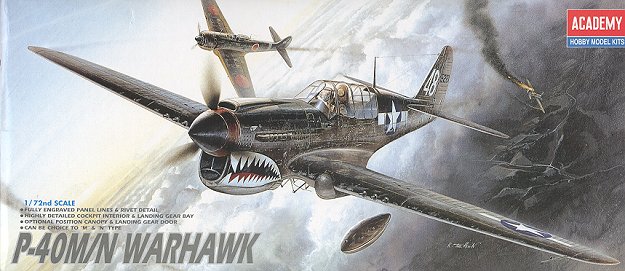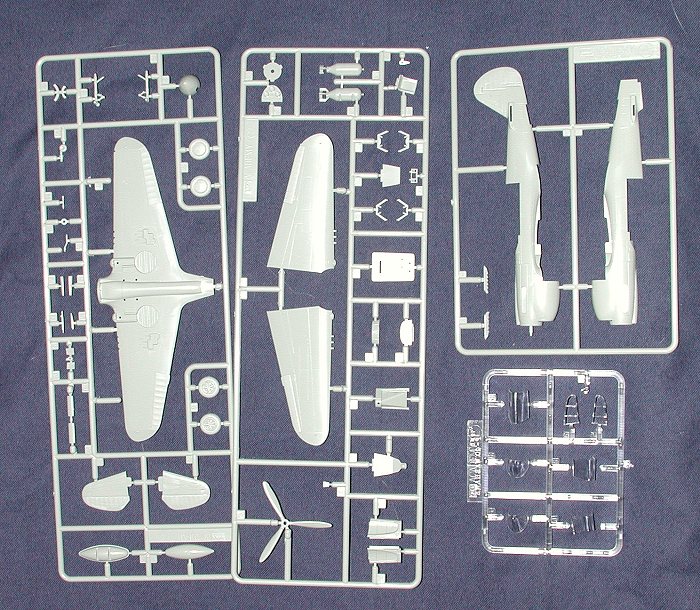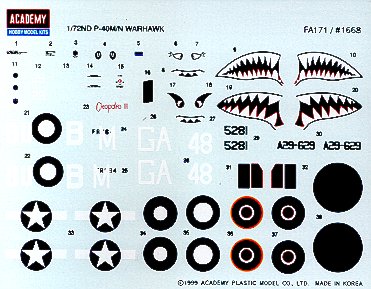
|
KIT: |
Academy 1/72 P-40M/N Warhawk |
|
KIT # |
1668 |
|
PRICE: |
$9.50 |
|
DECALS: |
Three aircraft |
|
REVIEW & |
|
|
NOTES: |

|
HISTORY |
Though the most used USAAF aircraft in the early years of the war, it was in the CBI (China/Burma/India) theater and in the Mediterranean where the Warhawk was most used. Long after it had ceased to be a really effective fighter, it soldiered on as a fighter-bomber. The rugged construction was a major factor in its ability to perform this task well. It was also supplied to a number of Allied nations until supplanted late in the war by more capable aircraft like the P-51 and P-47.
In China, where it wasn't up against technologically superior aircraft, it lasted as a front-line aircraft well into late 1944 and early 1945, when it was replaced by the P-51B and later P-51D Mustang. Built in very large numbers, the P-40 was the last great success of Curtiss aircraft. Follow-on projects were rife with delays and cost overruns. The debacle of the SB2C Helldiver was one of the last straws for what was once a giant in the field. Today, there are still a number of P-40s extant in museums the world over. Though not the prolific warbird that it was in the 60's, some can still be seen in the skies.
|
THE KIT |

Whenever I see an Academy kit in a scale and of a subject that has already been on the market, my first thought is to wonder whose kit was the basis for the release. In this case, it seems as if it is probably the Hasegawa kit. The overall feel of it is quite reminiscent. However, one thing I can say about Academy is that they generally improve on earlier kits and this one is no exception. The biggest thing you notice is that there are optional parts to do a P-40M, a version that has not been kitted in this scale before. This is accomplished by inserts that fit into the fuselage. In theory, it should work quite well, as the engineering is sound. In order to allow you to do a proper M or N, you get both canopy options. The canopy section itself is separate, though it may be a bit thick to allow you to display it in the open position.
Other benefits of this kit are a choice of wheels (with or without spokes), and the option of a drop tank or bomb. The interior has also been improved with separate rudder pedals, a nicely done instrument panel and a flap lever that is missing in the Hasegawa kit. Like the Hase kit, the wheel wells have some detail, but are too shallow. This kit also repeats the overly exaggerated protrusions aft of the shell ejector chutes. Also a bit overly done is the fabric representation of the control surfaces. Nothing a bit of sandpaper cannot tone down, though.
 The kit instructions are all
one would expect from today's kits. There are 11 construction steps and each has
painting information given. Some of the paints have FS 595 references to them.
There are three decal options, and Academy was kind enough to supply two full
sheets! Two of them are for P-40Ns. The first one is an OD over grey Warhawk
with the 74th FS, 23rd FW of the Flying Tigers in China. This plane has patches
of Medium green in various spots on the plane. Next is an RAAF P-40N of 80Sq
named Cleopatra III. This is in dark green over grey with white wing edges and
total empennage. It is also a scheme that is duplicated in the Hasegawa kit. The
final scheme is the lone P-40M. It is from 112 Sq RAF in Sicily so is in
dark earth and middlestone over azure blue with a red spinner. The decals
themselves are well printed and one of the two sheets was in perfect register.
The other was a bit off on the roundels. Note; the image was deliberately
darkened to show the white markings.
The kit instructions are all
one would expect from today's kits. There are 11 construction steps and each has
painting information given. Some of the paints have FS 595 references to them.
There are three decal options, and Academy was kind enough to supply two full
sheets! Two of them are for P-40Ns. The first one is an OD over grey Warhawk
with the 74th FS, 23rd FW of the Flying Tigers in China. This plane has patches
of Medium green in various spots on the plane. Next is an RAAF P-40N of 80Sq
named Cleopatra III. This is in dark green over grey with white wing edges and
total empennage. It is also a scheme that is duplicated in the Hasegawa kit. The
final scheme is the lone P-40M. It is from 112 Sq RAF in Sicily so is in
dark earth and middlestone over azure blue with a red spinner. The decals
themselves are well printed and one of the two sheets was in perfect register.
The other was a bit off on the roundels. Note; the image was deliberately
darkened to show the white markings.
Overall, it looks like a very nice kit and one that I'm sure 1/72 Warhawk fans will appreciate.
Review copy courtesy of your editor and his ever increasing credit card debt!!
If you would like your product reviewed fairly and quickly by a site that has over 1,700 visits a day, please contact me or see other details in the Note to Contributors.